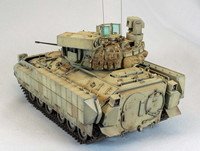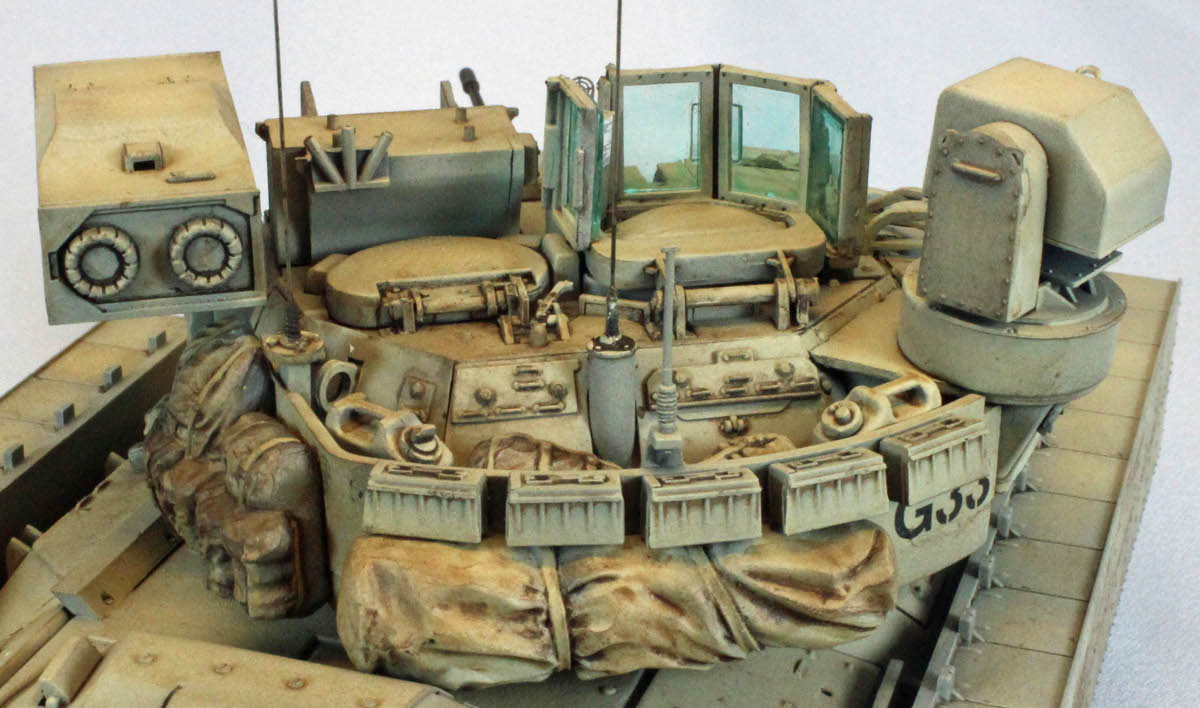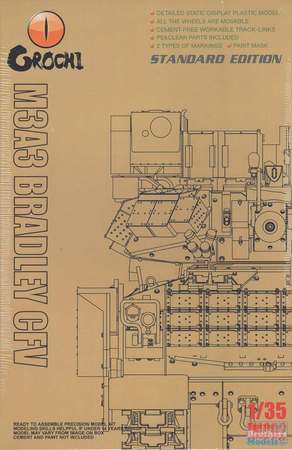
Orochi 1/35 M3A3 Bradley CFV
By Eric Christianson
Summary
New Chinese player Orochi scored an ace with their new M3A3 Bradley in a market flooded with M2/M3 Bradley vehicles. The kit has many of the features of the higher-end manufacturers but offers them at a much lower price and it represents one of the best values on the market. The biggest surprise is the tracks: Orochi has found a way to provide truly snap-together individual link tracks that stay together. The tracks are not some unusual variety that lend themselves to simple assembly, but standard run-of-the-mill U.S.A. AFV tracks. Innovations such as this and-value pricing-will motivate more modelers to try building armor.
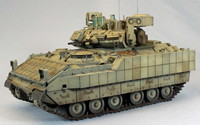
Background
The M3 Bradley Cavalry Fighting Vehicle (CFV) is an American tracked armored reconnaissance vehicle manufactured by BAE Systems Land and Armaments (formerly United Defense). It is based on the Bradley Fighting Vehicle family. The M3 CFV is used by heavy armored cavalry units in the U.S. Army. It is very similar to the M2 Bradley IFV (Infantry Fighting Vehicle) and shares its powerful two man 25mm Bushmaster Cannon turret with the coaxial 7.62mm machine gun. It only varies from the M2 in a few subtle ways and by role. The M3 is classified as an armored reconnaissance and scout vehicle and it does away with the firing ports found in the M2 series. The M3 also carries more TOW missiles as well as more ammunition for its 25mm and 7.62mm guns.
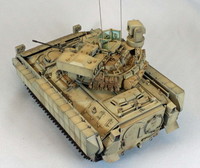
The Bradley family as a whole was originally intended to support the M113 APC (Armored Personnel Carrier) but ended up replacing it altogether. The Bradley is currently fielded in conjunction with the M1 Abrams series of main battle tanks and often accompanies infantry squads into combat. Bradleys and their powerful 25mm cannon/ TOW anti-tank missile combination destroyed more enemy tanks than the M1 Abrams in the 1991 Persian Gulf War. Only three Bradleys were lost to enemy fire; however at least 17 were lost to friendly fire. Improvements to the Bradley family have included enhanced identification features, as well as anti-tank missile countermeasures (for first generation wire-guided missiles only) and improved armor protection in the form of ERA.
What's in the Box
The box contains 6 individually wrapped sprues of soft, tan-yellow plastic. There is some minor flash in places. You get:
Separate upper and lower hulls
20 sprues of individual-link track made of hard black plastic
2 sprues of clear plastic parts
1 sprue of poly-caps allowing removal of the wheels for painting and weathering
1 small sheet of photo-etch containing grill covers and other detail
1 small brass painting template for wheels and tread
1 small sheet of decals
1 poly-urethane flap that fits over the base of the gun
A 13-page booklet of CAD-illustrated instructions with 31 steps, printed in black and white ink.
The decals are very thin but in perfect register. Apart from the box art there are no color schemes provided. The instructions include paint callouts for Tamiya Acrylic/Lacquers. The benefit of having very few pour-tabs and knock off pins on the sprues is slightly off-set by some pretty thick sprue-connection points in places.
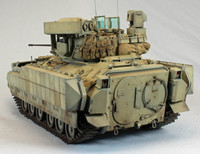
Things to consider before starting
Orochi thoughtfully provides the rubber portion of the wheels separately, which helps with painting and finishing. You will need to completely assemble, paint and mask off the lower hull before moving on to the upper hull. Once it is in place you will not have access to either the wheels and/or the tracks. I did not paint them separately in this build.
Decal placement is identified in the instructions throughout the build. I suggest you keep track of where things go, as access to some of the areas is difficult in the later stages of the build.
Orochi includes a 'Read Before Assembly' page in the instructions. It shows where to place 22 bolts/rivets that you remove from Sprue A. They are small and they require a deft touch to shave off the sprue and place on the surface of the upper hull and rear hatch.
There are many places in the build where the receiving 'female' divots for 'male' posts on parts are not deep enough, resulting in parts standing proud of the surface. You should drill out the divots before applying glue.
The large storage basket at the back of the turret needs something, so I went to my stash of Value Gear products for things that would fit in there. Likewise for the antenna: there are none in the kit. I used Orange Hobby's excellent products for those.
The Instructions
The instructions are excellent and show that Orochi took a lot of care to get things right. I only found one oddity: there is no three view drawing or color schemes provided - several times I had to resort to the Internet to find where and how parts should be placed.
Construction
Lower Hull and suspension
The build begins with the lower hull and suspension, and this is where you encounter your first (and just about only) significant issue. The small, nylon poly caps inserted inside the wheels in Step 2 cause fit problems in Step 4. The caps allow the wheels to be removable, but don't exactly fit the wheel posts. They fit, but something is preventing them from easily slipping on. The poly caps are likely too small for the cavity they sit in and can end up just off center when sandwiched between the two wheel halves. Whatever the case the posts are not strong enough to withstand wear and tear: they will easily bend and could break before you manage to get the wheel on. Adding insult to injury the poly caps inside the drive sprockets don't engage the posts at all.
I recommend leaving the poly caps out. They create more trouble than they are worth, and removable wheels is of little value once the upper hull is attached anyway. On the other hand the fit of the tires over the wheels is excellent and does not even require glue.
The Tracks
The tracks are assembled and attached in Step 5. The two runs of track in this kit are made of black, individual-link plastic parts that 'chunk' together. They hold remarkably well after connected. Take a link in your left hand and one in your right hand, slip the right hand link into the top of the left hand one and push the bottoms together until you feel (and hear) a solid 'chunk'. Do that 78 more times and you have a complete run. I had both runs done in about 20 minutes! Careful removal of the links from the sprue even eliminates the need for clean-up, although purists might differ. The sprue separation points are hidden on the completed track. The toughest part was getting that last link together while the run was on the model. I managed to get the first side done, but for the second side I decided to scrape off the tiny pins and glue the last link in place.
While these tracks are amazing, they will come apart if enough torque or pressure is applied. I recommend hitting the runs with a little Tamiya Liquid cement once the tracks are in place. The instructions call for 79 links per side, which is spot on, with 10 links left over. Great job, Orochi!
I sprayed the lower hull and track with a layer of pre-shade black, followed by an initial camouflage coat of Buff on the wheels (see painting notes, below for specific brands) before moving on. Once the upper hull is seated you will have very limited access to this area.
Upper Hull, Rear and Main Deck
The placement of several parts (C1, C21) in Steps 11 and 12 would have benefited from a three-view image of the vehicle. In Step 14, the three prominent armor sections that adorn the front of the vehicle sit on a set of 12 vertically-arranged spacers and rely on numerous tiny bumps to line up, a task beyond my modeling skills. If I had a good overhead shot of this area these would have been easier to place. The instruction have a single overhead illustration included (for the rivet placement) which curiously lacks any of this detail. If the little 4-part assembly at the top of Step 11 has you confused, you're not alone. I placed Part C36 where I thought it should go, and discarded Part C7. If you can make these parts fit where they are supposed to go on the hull, good for you!
Turret
The fit and finish of nearly everything on and around the turret was superb. Many of the smaller parts and assemblies looked complicated but came together perfectly, even the weird rubbery flap covering the main weapon's base. Normal hobby cement secured it in place.
I painted the sectional shield frame around the commander's hatch without the glass in place. After dipping the glass in Alclad (See Painting Section, below), I inserted it into the shield but waited to attach the assembly until the very end of the build, so the clear parts would not be affected by airbrushing. In Step 21, the placement of Part C44 as shown will impede the fit of the turret onto the turret ring of the main hull, so I left it off.
Orochi did not provide any content for the turret bustle on the Bradley. I went to my spares box for period-appropriate baggage to fill up the void, including, conveniently, the big blank spot where the (torn and destroyed) decal would normally go. If you decide to leave the storage area empty, note that several prominent and visible ejection pin holes on the inside of the bustle will need to be filled.
Painting and Finish
I finished the M3A3 in a basic, one-color desert camouflage scheme. I preferred to highlight and accent the monochrome finish with filters and washes. The kit can be completely assembled before painting, except the antenna and armored glass sectional.
Primer and Pre-Shade
I started by airbrushing a primer/pre-shade coat of Gunze Mr. Finisher 1500 Black. This lacquer primer gives the plastic and PE some grip for the following coats and fills in the recesses and creates a shadow effect near the flat surface edges, adding depth for the subsequent coats to come. I really like Gunze's new product; it goes on beautifully and combines what used to be two coats of paint applied in two sessions into one. I allowed that to sit overnight to de-gas.
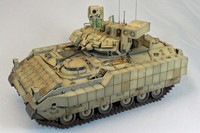
Airbrushing Vallejo Model Color Paints with a (siphon-feed) Paasche H Airbrush
I used Vallejo Model Color paints in my continuing transformation over to true acrylics. I went through a bit of experimentation up front, but eventually found them to spray beautifully once I dialed in the right setup and thinning ratio. First, I dialed the pressure up to 20-25lbs (Vallejo recommends 12-15lbs). I think the higher pressure is needed because I use a siphon-style airbrush (Paasche H) as opposed to a gravity-feed airbrush. Once I did that, the spray pattern evened out and I lost the scatter-shot look of the paint on the surface.
Next, regardless of what line of Vallejo paint used (Model Air, Model Color, or Panzer Color), I found that adding a single drop of Liquitex Flow Aid and a hefty squirt of Vallejo Air brush Thinner to each cup worked well and almost never clogged. A Q-tip moistened with Vallejo thinner was kept nearby for knocking off the tiny 'paint clod' that would form on the nozzle tip when minor clogging did occur. Cleaning the airbrush afterwards became a must-do chore. This is a departure from using other paints, when I just blew some thinner through the airbrush and put it away. On the flip side, Vallejo paints are odor-free, allowing me to swap my heavy, uncomfortable vapor mask (for distillate-based paints) for a simple painter's (particulate) mask.
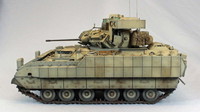
Camouflage
I followed the pre-shade coat with Vallejo's Model Color 70976 Buff. I next laid down a light coat of Model Air 71.075 Sand on the upper surfaces. What starts out looking yellow-green ends up as a nice pale yellow. I worked each color from the center of the panels outward to preserve some of each color showing through from underneath. Some parts I left the original darker yellow and some parts were nearly ivory-white, depending on where I thought the sun would hit, achieving sort of a forced-color perspective.
Filters
I applied an overall filter of Mig Wash Brown while the surfaces were still flat, and used AK Interactive Track Wash on the track and a Mig 110 Black filter on the fenders, extra track links and the engine grills. I went back and added second and third filter coats to specific areas to break up the monochrome surfaces. I thin all of my washes and filters with Mona Lisa Odorless Thinner, which will not affect underlying layers of paint.
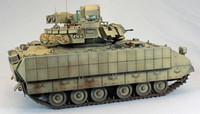
Decals
I airbrushed a coat of Future over the entire vehicle to set it up for decals once dry. I applied the decals using the Red and Blue Micro Sol/Set system without any problems, followed by an additional layer of Future to seal them. The decals were perfectly registered but very, very thin and thus prone to tearing easily. Orochi chose to show the paint callouts and decal placement throughout the instructions instead of in a single section. The placement of the large unit number on the starboard side of the turret is not shown, so I put it where it could fit.
Pin Wash
I applied a pin wash of Mig Dark Wash (aka Raw Umber) straight from the bottle using a small red sable brush, concentrating on the panel lines, recesses, buckles, on-board tools, etc.
On-Board Tools
(Note: For hand-brushing Vallejo paints, I put a drop of Vallejo Slow Dry and a drop water onto an old CD and then single drop of all the colors I need. I mix the colors with the water and slow dry until the paint flows smoothly off a red sable brush.)
I painted the wooden portions of the tools with a mixture of Vallejo Panzer Aces New Wood (311), Old Wood (310) and German Cam Medium Brown (Model Color 70822). I brushed on a little Mig Wash Brown oil paint straight from the tube and let that set overnight, to give the wooden parts of the tools more depth. Don't let this paint leach out its oil beforehand, like you would when using oil paints for dry-brushing. The oil helps it stay workable. In the morning I carefully removed most of the oil paint using a brush dampened with Mona Lisa Paint Thinner, leaving the areas near the latches and metal parts darker than the center of the wooden shafts. I painted all the steel parts Vallejo Oily Steel. I then let a little Mig 110 Black wash puddle up on the horizontal surfaces of the metal axe and shovel heads. When dry, I think this gives them a convincing look of used steel.
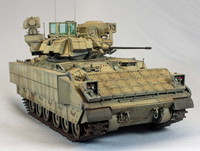
Other details
I left the main barrel black from the pre-shade step, went over it with a silver quilter's pencil to highlight the protruding parts, and then hit it with all the washes and filters as I went along. I think this gives it a convincing look in the end. I painted the lights Tamiya X7 Red and Tamiya Chrome Silver, and added a drop of Future when they were dry, to suggest glass covers. I painted the backpacks and tarps Buff (Vallejo Model Color) and Canvas, liberally adding filters and washes using Mig Wash Brown and Mig Dark Wash.
Armored Glass
The M3A3 Bradley has a four-piece section surrounding the commander's hatch that sports armored glass. Before I added the glass sections I dipped them in un-diluted Alclad Armored Glass Lacquer, and let the paint wick off and dry before attaching them. I weathered this section separately and attached it at the very end of the build.
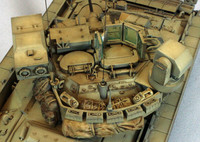
Road Dust and Final Assembly
Finally, I applied a 'road-dusting' coat consisting of Vallejo Model Air Sand (Ivory; 71.075), followed by a coat of Vallejo Flat Varnish to kill any shiny spots still remaining. I cut each of these 50/50 with Vallejo Airbrush Thinner and a drop of Liquitex Flow Aid to improve flow. Once everything was dry I dusted some Mig Russian Earth and Black pigments on the sides of the armor here and there and the tracks as well, to rough up the visible surfaces a little. I attached the antenna and the armored glass sectional and this busy little guy was done!
Conclusion
The M3A3 Bradley was a lot of fun to build, and an unbelievable value for the price. I think Orochi did an excellent job of translating the busy look of a modern U.S. AFV into this scale representation. A perfect kit would have included stowage gear for the turret bustle and a three-view drawing, but might have cost more as well. I think what you get in the box is a good compromise and a great value.
The tracks are magnificent. Purists might find inaccuracies and opt for after-market replacements, but once all the paint and pigment is applied, who would know? The easy snap-assembly of the links will attract new armor modelers to the fold, and there's nothing wrong with that.
There are design issues with some of the assemblies, and the instructions could use better angles in the drawings. That said, I can recommend this kit to all levels of model builders. If you go slow and follow the suggestions above, you should be able to have a lot of fun building kit.
I would like to thank Orochi Models and Stevens International for providing this kit for review, and to Internet Modeler for giving me the opportunity to build it.
